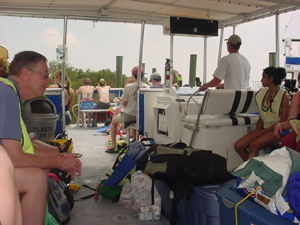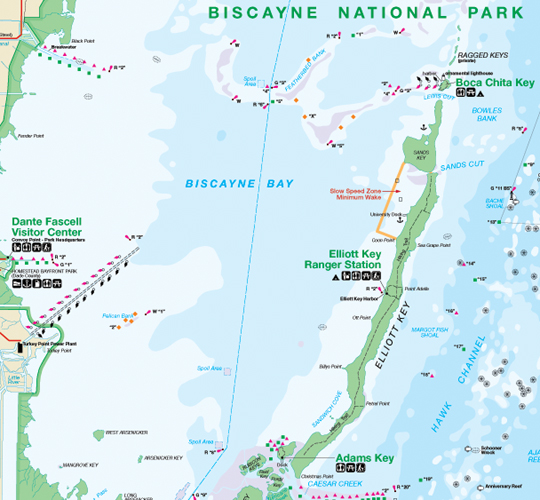
Snorkeling on coral reef draws visitors
HOMESTEAD, Fla.— The bright sun shines overhead as a Cormorant spots a small fish for its lunch. The breeze moves the white clouds slowly, occasionally providing shade.
Aquamarine waves lap alongside the stern of the large white boat as it drops anchor. Small clumps of seaweed drift along with the slight current. Beneath these crystal waters lies one of the largest of nature’s marine wonders, the coral reef.
Coral reefs have always amazed the human mind. Books, movies, television shows and documentaries have all been produced to further explain and depict the natural beauty found below the surface of the Atlantic and Pacific Oceans.
 |
| A boat filled with snorkelers and campers— and their gear— make the trip to Elliott Key (Photo by Yenisse Alonso). |
According to the National Park Service (http://www.nps.gov/bisc/), the coral reef of the Florida Keys is North America’s only living coral barrier reef and the third longest coral barrier reef in the world.
Although it is highly protected, one of the best ways to get an up-close and personal look at this reef is through Florida’s own Biscayne National Park and its snorkeling program.
For $35, this three-hour activity takes snorkelers by boat to the nearing coral reef where various forms of sea life native to the reef can be observed in their natural splendor.
Before leaving the dock, a park ranger gives snorkelers a 15-minute briefing at the Dante Fascell Visitor Center on the various marine life and vegetation that may be observed during their exploration of the reef. Also, boating safety precautions are reviewed by the captain, such as where the life jackets are located and what to do in case of emergency. The boat ride lasts about an hour, depending to which part of the reef visited.
Once the captain drops anchor along the fringes of the reef, a briefing is given in regards to coral reef etiquette and snorkeling safety. Instructions are given to just observe the wildlife on the reef and not to touch any of the coral in order to aid in the conservation of the natural wonder. Touching the coral can result in killing it, as well as putting the snorkeler at risk of developing an allergic reaction, at the minimum. The first mate also instructs first-timers on how to go about swimming along the reef.
A tutorial on how to use the snorkeling equipment is also given. All equipment, which includes a mask, snorkel, fins, and snorkeling vest, is provided at the visitor center before departure. All of the equipment is optional, with the exception of the snorkel vest.
After snorkelers have placed on their gear, they are allowed free range along the reef for about an hour and a half to observe the reef in its natural and purest form.
As previously mentioned, there are a variety of sea creatures that can be viewed throughout the trip.
Snorkeler Sarah Carter, a tourist from Kennebunkport, Maine, said Parrot Fish, Tang, Trunkfish, Trumpet Fish, Bar Jack Fish, and Grunts were seen on her snorkeling experience.
Other sea creatures reportedly seen around the coral reef area are eels, sea turtles, Sergeant Major and Manta Rays, to only name a few. The soft corals themselves are live marine animals, contrary to their vegetative appearance. Dolphins can also be seen playing alongside the snorkel boat as it heads to and from the dock at the Dante Fascell Visitor Center.
“It [the snorkeling experience] was fabulous,” said Denise Rodino, a resident of Massachusetts who visited Biscayne for the first time and said she would recommend it to anyone. “You’re out here all by yourself. It’s very pristine and clean. It’s very natural with lots of great fish and beautiful coral.”
Snorkel trips are subject to the weather conditions. If the winds and the gust are above 15 miles per hour, it is at the captain’s discretion whether or not the snorkel trip is kept inside the protected waters of Biscayne Bay. Although a different eco-system from the coral reef, the bay has many specimens of marine life to observe such as manta rays, sea turtles, and dolphins.
To make reservations to embark on your own coral reef encounter, call the Dante Fascell Visitor Center at 305-230-1100. The visitor center is located at 9710 SW 328th St., Homestead, FL, and its operating hours are from 9 a.m. to 5 p.m.
 |
| Snorkeling trips travel from the Dante Fascell Visitor Center to the coral reef areas east of Elliott Key (Map courtesy of the National Park Service). |

Comments are Closed